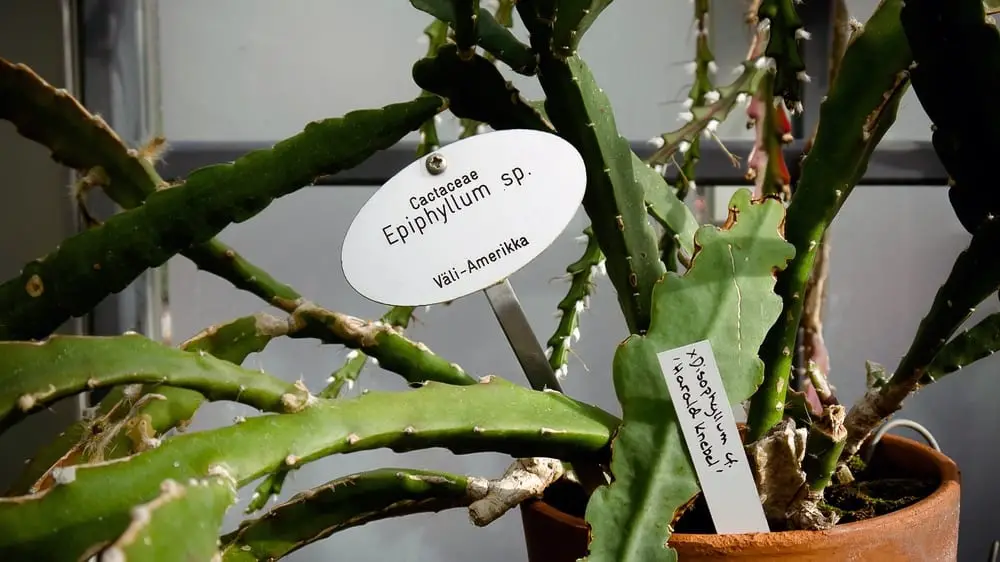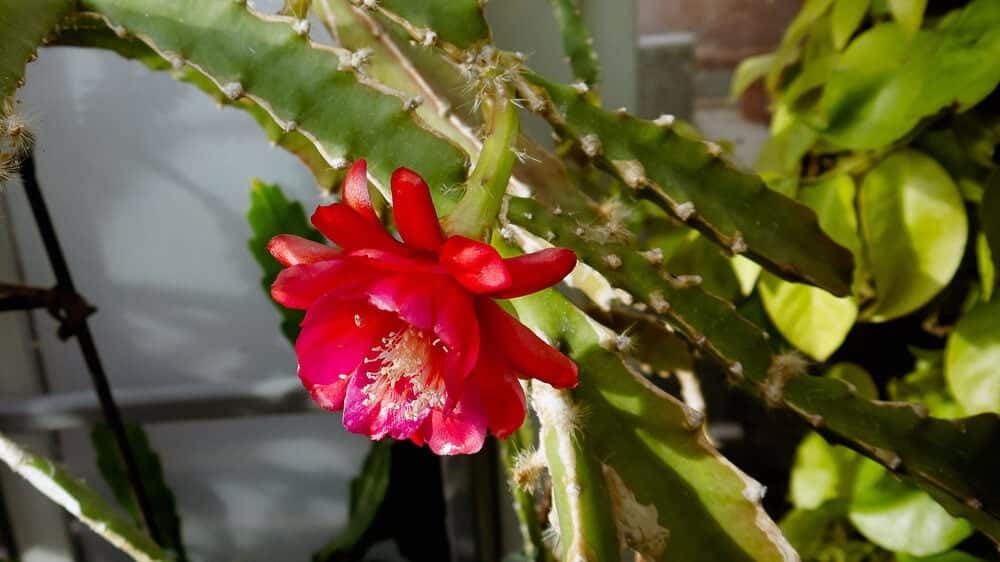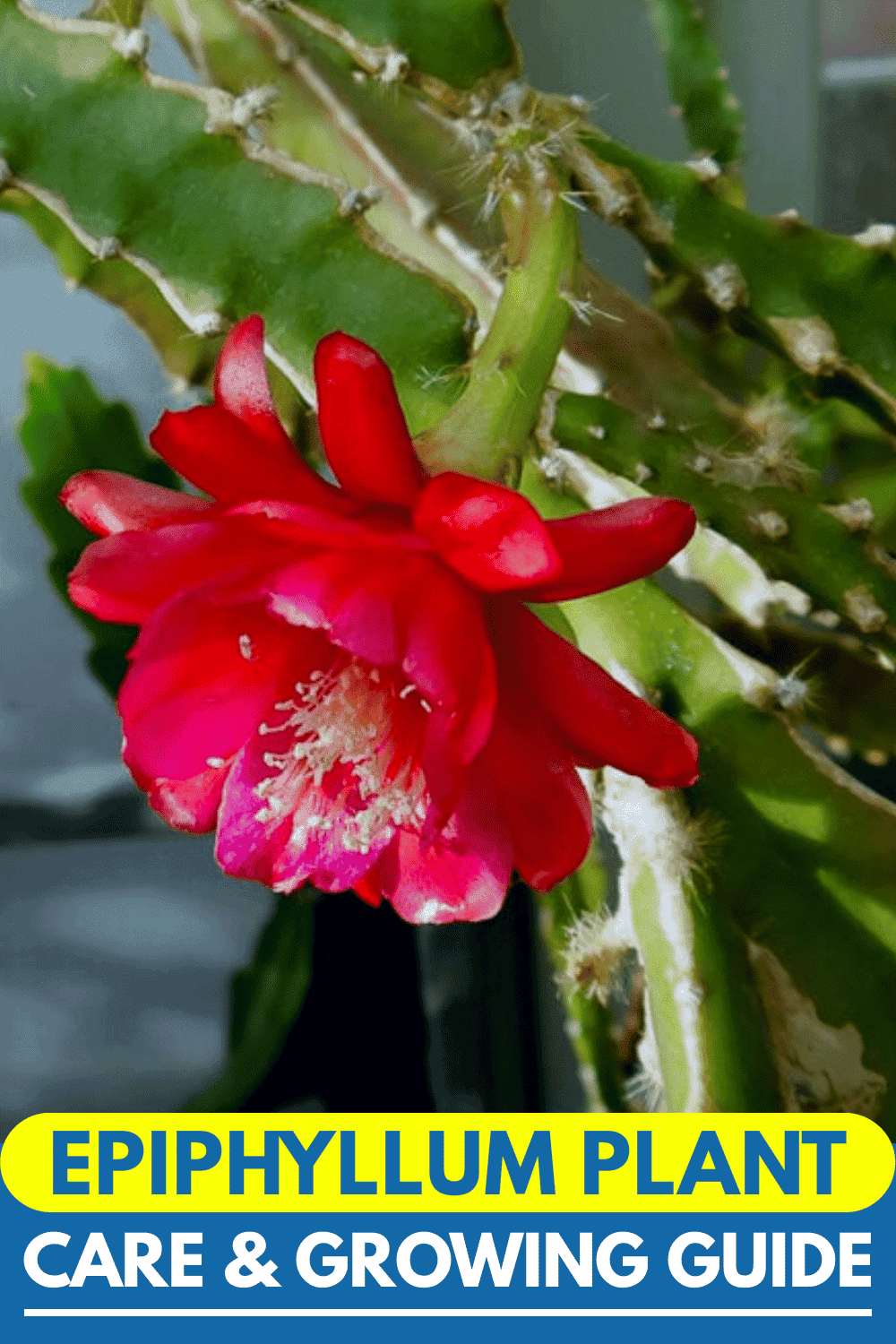Epiphyllum plants are part of the cactus family, and there are about 19 varieties to care for.
These cactus plants have flowers growing from them. These plants and not like succulent because they need more attention and care.
Epiphyllum Plant Care & Growing Guide
1. Light requirements
An Epiphyllum plant should not be in direct sunlight. It needs to be in full indirect light. But you can place them in an area that receives full morning sunlight. But by noon, they need to be far away from the sun’s rays. It also does well under artificial light as long as they are bright.
2. Water
Giving the correct amount of water to an Epiphyllum plant is tricky at first. The soil around the roots should never become dry but overwatering these plants will kill them. But during the winter, it should be minimally watered to prevent the root from drying up.
3. Climate and temperatures
The weather an Epiphyllum plant can stand varies, but most of these plants can live well between the temperatures of 40 to 95F degrees. All Epiphyllum plants love the humidity and thrive when the moisture in the air is at least 50% humidity, which is very high. If these plants experience temperature lower than 35F, it will wither and die.
4. Soil
If an Epiphyllum plant is an indoor plant, then you can use any basic potting soil. Add a bit of perlite to make it easier for water to drain away. You can also use potting soil in the ground if that is where you’re planting your Epiphyllum. If you are planting the Epiphyllum outside, the soil’s ph needs to be around 6.5, and it should not be able to hold onto water.
5. Repotting
It is recommended that you repot an Epiphyllum plant once in seven years. To repot it, wait until a month after the flower has bloomed. Remove it from its soil completely and gently shake off excess soil. Repot it in fresh soil and wait a week before watering it. Water it sparsely for a month after repotting, then resume regular watering.

6. How to propagate the Epiphyllum
The way to propagate an Epiphyllum plant is through its leaves. You can remove a leaf from the plant, but make sure the leaf you choose is strong and healthy.
- First, cut off a leaf that is at least 4 inches in height.
- Second, you have to let this cutting develop a scab so that it doesn’t get an infection from the soil when you place it in its new pot. Leave it in a cool area for around ten days.
- Third, once the scab has developed, place the cutting in its new container and place it in one inch into the soil. The plant will fall over, so try to stabilize.
Don’t water the plant until the cutting develops roots. At this stage, it has no roots and can rot from the moisture and the soil.
7. Height and spread
If you allow the Epiphyllum to grow and not try to stunt it, these types of plants reach up to 10 feet tall. Their spread can be up to three feet, so they’ll take up a good amount of room if they are houseplants.
8. Do Epiphyllum plants have flowers, and how do I help them bloom?
Yes, the Epiphyllum has a large flower that sits on top of the cactus. It can be any color, but most likely, it will be red, orange, pink, or yellow. For a cactus flower to bloom, it must be in indirect but bright sunlight. And do not overwater the cactus. These flowers usually bloom from August to mid-October, not in the springtime. Some flowers only bloom at night, when the weather is colder.
9. Trimming
The blade or scissors you use to trim this plant must be very clean. Sterilized instruments are even better. To trim the Epiphyllum, take out all of the dead or rotting growth first and make sure to remove it all, down to the base of the stem. This will allow the plant to send more energy to new growth. Next, when the flower blossom dies, cut off the blub at the right before the head. Then, cut off all leggy stems that have no growth on them.

Is the Epiphyllum plant poisonous?
No, the Epiphyllum plant is completely non-toxic and won’t harm children or animals. It’s not edible; it’s just not poisonous.
Can plants grow in water?
No, the Epiphyllum plant cannot be grown in water. Many of the diseases it suffers from is a result of being overwatered, so living in water is sure to kill it.
Also read: Spider Plant (Chlorophytum) Care & Growing Guide
Common Plant Diseases and pests
Fungal Leaf Spots can happen when the wind carries fungal spores and the spore land on wet leaves, and the weather is warm. So if there are rainstorms in your area that occur during the summer, you should monitor your plants. You can identify fungal leaf spot by looking for yellow spots on your Epiphyllum green leaves. To get rid of this fungus, first, you must remove all of the leaves that have the spots. Then, you can spray the plant with a fungicide.
Stem disease harms the epiphyllum plant by creating sores at the base of the plant. If left untreated, it can slowly rot away the stems and roots of the plant and kill it. To treat stem disease, you must repot Epiphyllum in brand new soil, because the rot can live in the soil. Remove any dead part of the plant that can be removed and spray a fungicide on the affected part. Do not water the plant until you see improvement.
Learn more: Haworthia Cooperi Care & Growing Guide
Conclusion
- Many of the Epiphyllum’s diseases are caused by excessive moisture.
- The Epiphyllum is another name for the orchid.
- These types of plants regularly live off the dying matter of plants around them.
- Epiphyllum plants are not orchids are all, even though their genus is called the orchid cacti.
- Their root should never be dry. Always keep the roots slightly moist.
- You have to sterilize your blade or scissors before you cut off a piece of the orchid to propagate.

Victoria is the owner and main author of hobby plants. She loves spending her free time in her garden planting and taking care of her plants. Victoria hopes you enjoy the content here!
![Mother Of Thousands Plant [Complete Plant Care Guide] Mother Of Thousands Plant [Complete Plant Care Guide]](https://www.hobbyplants.com/wp-content/uploads/2022/07/mother-of-thousands-plant-300x158.jpg)
![Majesty Palm Plant Care: [Complete Beginner's Guide] Majesty Palm Plant Care: [Complete Beginner's Guide]](https://www.hobbyplants.com/wp-content/uploads/2022/08/majesty-palm-care-300x158.jpg)
![Exotic Angel Plant Care: [Complete Beginner's Guide] Exotic Angel Plant Care: [Complete Beginner's Guide]](https://www.hobbyplants.com/wp-content/uploads/2022/08/exotic-angel-plant-care-300x158.jpg)
![Snow White Waffle Plant: [Complete Care Guide] Snow White Waffle Plant: [Complete Care Guide]](https://www.hobbyplants.com/wp-content/uploads/2022/08/snow-white-waffle-plant-300x158.jpg)
![Waffle Plant Care: [Complete Beginner's Guide] Waffle Plant Care: [Complete Beginner's Guide]](https://www.hobbyplants.com/wp-content/uploads/2022/08/waffle-plant-300x158.jpg)
![Bird Of Paradise Plant Care: [Complete Beginner's Guide] Bird Of Paradise Plant Care: [Complete Beginner's Guide]](https://www.hobbyplants.com/wp-content/uploads/2022/08/bird-of-paradise-plant-300x158.jpg)
![Purple Passion Plant Care: [Complete Beginner's Guide] Purple Passion Plant Care: [Complete Beginner's Guide]](https://www.hobbyplants.com/wp-content/uploads/2022/08/purple-passion-plant-care-300x158.jpg)
![China Doll Plant Care: [Complete Beginner's Guide] China Doll Plant Care: [Complete Beginner's Guide]](https://www.hobbyplants.com/wp-content/uploads/2022/09/china-doll-plant-care-300x158.jpg)
![Polka Dot Plant Care: [Complete Beginner's Guide] Polka Dot Plant Care: [Complete Beginner's Guide]](https://www.hobbyplants.com/wp-content/uploads/2022/09/polka-dot-plant-300x158.jpg)
![Mona Lisa Lipstick Plant Care: [Complete Beginner's Guide] Mona Lisa Lipstick Plant Care: [Complete Beginner's Guide]](https://www.hobbyplants.com/wp-content/uploads/2022/09/lipstick-plant-mona-lisa-300x158.jpg)
![Yucca Cane Plant Care: [Complete Beginner's Guide] Yucca Cane Plant Care: [Complete Beginner's Guide]](https://www.hobbyplants.com/wp-content/uploads/2022/09/yucca-cane-plant-care-300x158.jpg)
![Bush On Fire Croton Plant Care: [Complete Beginner's Guide] Bush On Fire Croton Plant Care: [Complete Beginner's Guide]](https://www.hobbyplants.com/wp-content/uploads/2022/09/bush-on-fire-croton-300x158.jpg)